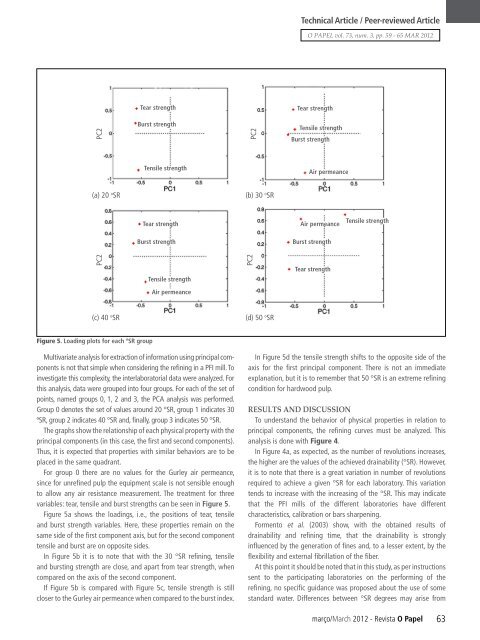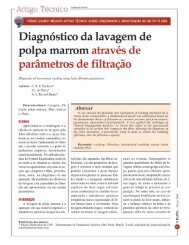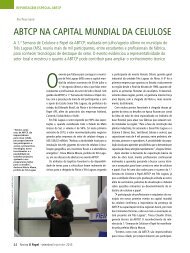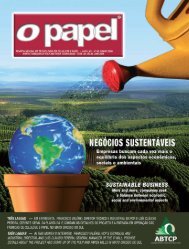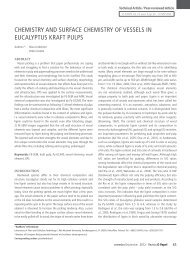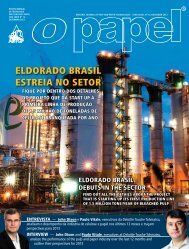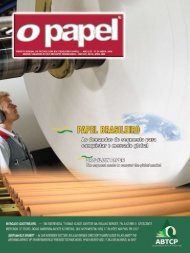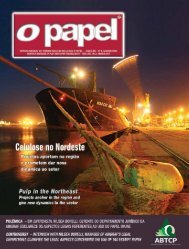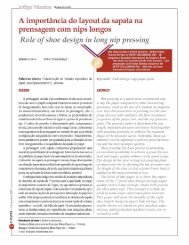BIOECONOMIA - Revista O Papel
BIOECONOMIA - Revista O Papel
BIOECONOMIA - Revista O Papel
Create successful ePaper yourself
Turn your PDF publications into a flip-book with our unique Google optimized e-Paper software.
Technical Article / Peer-reviewed Article<br />
O PAPEL vol. 73, num. 3, pp. 59 - 65 MAR 2012<br />
Tear strength<br />
Tear strength<br />
PC2<br />
Burst strength<br />
PC2<br />
Tensile strength<br />
Burst strength<br />
Tensile strength<br />
Air permeance<br />
(a) 20 o SR<br />
(b) 30 o SR<br />
Tear strength<br />
Burst strength<br />
Air permeance<br />
Burst strength<br />
Tensile strength<br />
PC2<br />
Tensile strength<br />
PC2<br />
Tear strength<br />
Air permeance<br />
(c) 40 o SR<br />
(d) 50 o SR<br />
Figure 5. Loading plots for each ºSR group<br />
Multivariate analysis for extraction of information using principal components<br />
is not that simple when considering the refining in a PFI mill. To<br />
investigate this complexity, the interlaboratorial data were analyzed. For<br />
this analysis, data were grouped into four groups. For each of the set of<br />
points, named groups 0, 1, 2 and 3, the PCA analysis was performed.<br />
Group 0 denotes the set of values around 20 °SR, group 1 indicates 30<br />
ºSR, group 2 indicates 40 °SR and, finally, group 3 indicates 50 °SR.<br />
The graphs show the relationship of each physical property with the<br />
principal components (in this case, the first and second components).<br />
Thus, it is expected that properties with similar behaviors are to be<br />
placed in the same quadrant.<br />
For group 0 there are no values for the Gurley air permeance,<br />
since for unrefined pulp the equipment scale is not sensible enough<br />
to allow any air resistance measurement. The treatment for three<br />
variables: tear, tensile and burst strengths can be seen in Figure 5.<br />
Figure 5a shows the loadings, i.e., the positions of tear, tensile<br />
and burst strength variables. Here, these properties remain on the<br />
same side of the first component axis, but for the second component<br />
tensile and burst are on opposite sides.<br />
In Figure 5b it is to note that with the 30 °SR refining, tensile<br />
and bursting strength are close, and apart from tear strength, when<br />
compared on the axis of the second component.<br />
If Figure 5b is compared with Figure 5c, tensile strength is still<br />
closer to the Gurley air permeance when compared to the burst index.<br />
In Figure 5d the tensile strength shifts to the opposite side of the<br />
axis for the first principal component. There is not an immediate<br />
explanation, but it is to remember that 50 °SR is an extreme refining<br />
condition for hardwood pulp.<br />
RESULTS AND DISCUSSION<br />
To understand the behavior of physical properties in relation to<br />
principal components, the refining curves must be analyzed. This<br />
analysis is done with Figure 4.<br />
In Figure 4a, as expected, as the number of revolutions increases,<br />
the higher are the values of the achieved drainability (°SR). However,<br />
it is to note that there is a great variation in number of revolutions<br />
required to achieve a given °SR for each laboratory. This variation<br />
tends to increase with the increasing of the °SR. This may indicate<br />
that the PFI mills of the different laboratories have different<br />
characteristics, calibration or bars sharpening.<br />
Formento et al. (2003) show, with the obtained results of<br />
drainability and refining time, that the drainability is strongly<br />
influenced by the generation of fines and, to a lesser extent, by the<br />
flexibility and external fibrillation of the fiber.<br />
At this point it should be noted that in this study, as per instructions<br />
sent to the participating laboratories on the performing of the<br />
refining, no specific guidance was proposed about the use of some<br />
standard water. Differences between °SR degrees may arise from<br />
março/March 2012 - <strong>Revista</strong> O <strong>Papel</strong><br />
63


